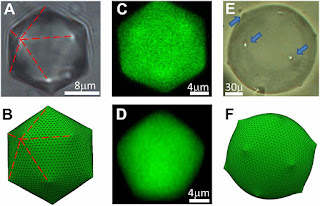We tend to think of liquids as not breaking continuous rotational or translational symmetry. If you consider timescales long compared to the jostling motion of atoms or molecules in a liquid, all positions look about the same, as do all directions in space. (It is possible to have intermediate situations, with liquids made from non-spherical molecules, and these can have directionality and local clustering. Such liquid crystals are used in the display you're most likely using to read this.) The lack of translational and rotational symmetry breaking in liquids is one reason that droplets (and bubbles) tend to be spherical. If it is energetically expensive to have an interface between, say, oil in water, for a fixed volume of oil, then the lowest energy situation is to have a spherical oil droplet - that minimizes the surface area of interface.
 |
| Fig. 1 from Guttman et al., PNAS 113, 493-496 (2016). Faceted oil droplets! |
Yesterday I stumbled upon this paper, and that sent me down a literature rabbit-hole. This Nature paper (archived version here) led me to this PNAS paper, where I grabbed Fig. 1 at right. It turns out that it is possible to form faceted liquid droplets of certain oils (alkanes) in aqueous suspensions. The outermost layer of the alkanes acts rather like a lipid membrane, and it is possible to sit at a temperature where that layer crystallizes (the molecules in it spontaneously break translational and rotational symmetry) while the bulk of the droplet remains a liquid. What picks out the orientation of the resulting faceted shape? Spontaneous symmetry breaking. Tiny fluctuations or attributes of the local environment. Wild!
1 comment:
Great Article! It really is amazing when things break the norm!
Post a Comment